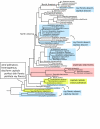Molecular phylogeny of Subtribe Artemisiinae (Asteraceae), including Artemisia and its allied and segregate genera
- PMID: 12350234
- PMCID: PMC130036
- DOI: 10.1186/1471-2148-2-17
Molecular phylogeny of Subtribe Artemisiinae (Asteraceae), including Artemisia and its allied and segregate genera
Abstract
Background: Subtribe Artemisiinae of Tribe Anthemideae (Asteraceae) is composed of 18 largely Asian genera that include the sagebrushes and mugworts. The subtribe includes the large cosmopolitan, wind-pollinated genus Artemisia, as well as several smaller genera and Seriphidium, that altogether comprise the Artemisia-group. Circumscription and taxonomic boundaries of Artemisia and the placements of these small segregate genera is currently unresolved.
Results: We constructed a molecular phylogeny for the subtribe using the internal transcribed spacers (ITS) of nuclear ribosomal DNA analyzed with parsimony, likelihood, and Bayesian criteria. The resulting tree is comprised of three major clades that correspond to the radiate genera (e.g., Arctanthemum and Dendranthema), and two clades of Artemisia species. All three clades have allied and segregate genera embedded within each.
Conclusions: The data support a broad concept of Artemisia s.l. that includes Neopallasia, Crossostephium, Filifolium, Seriphidium, and Sphaeromeria. However, the phylogeny excludes Elachanthemum, Kaschgaria, and Stilnolepis from the Artemisia-group. Additionally, the monophyly of the four subgenera of Artemisia is also not supported, with the exception of subg. Dracunculus. Homogamous, discoid capitula appear to have arisen in parallel four to seven times, with the loss of ray florets. Thus capitular morphology is not a reliable taxonomic character, which traditionally has been one of the defining characters.
Figures


References
-
- Heywood V, Humphries C. Anthemideae-Systematic review. In: V Heywood, C Humphries, B Turner, editor. The Biology and Chemistry of the Compositae. Academic Press; 1977.
-
- Bremer K, Humphries C. Generic monograph of the Asteraceae-Anthemideae. London, Bull Nat Hist Museum. 1993;23:1–177.
-
- Oberpreiler C, Vogt R, Watson L. Tribe Anthemideae, In: J Kadereit, editor. Families and Genera of Vascular Plants. Berlin, Springer-Verlag; 2003.
-
- Bremer K. Asteraceae: Cladistics and Classification. Portland, OR, Timber Press. 1994.
-
- Shreve F. The desert vegetation of North America. Bot Rev. 1942;8:195–246.
Publication types
MeSH terms
Substances
LinkOut - more resources
Full Text Sources

